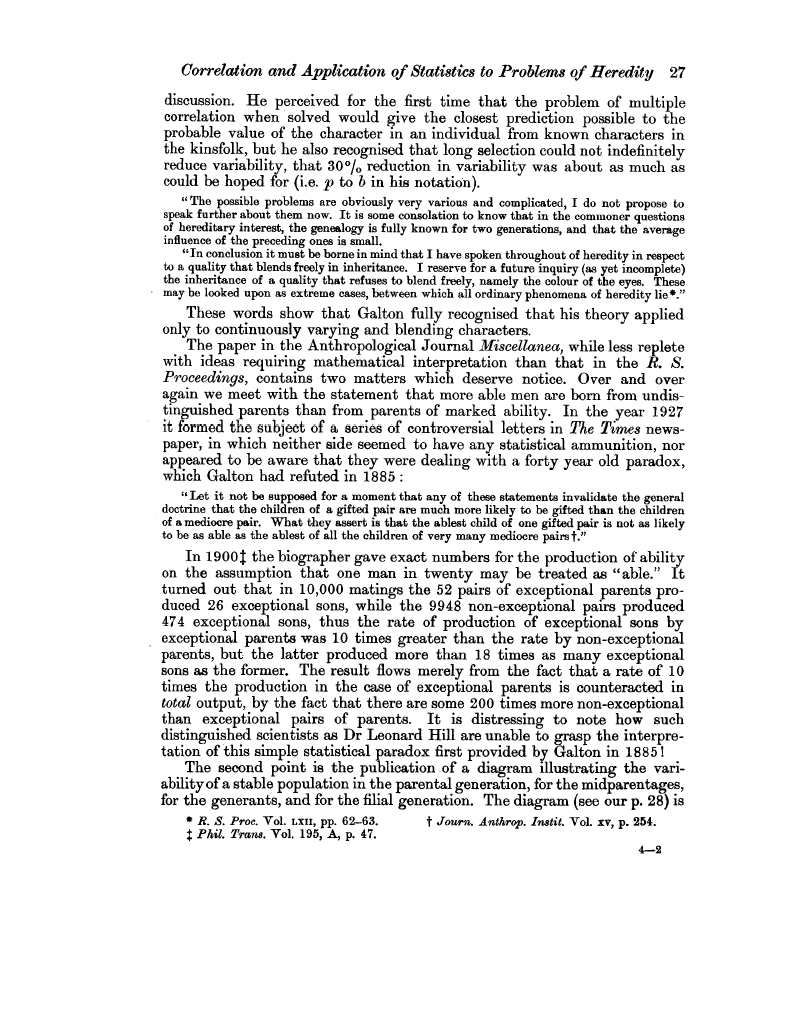| ||||||

OCR Rendition - approximate
Correlation and Application of Statistics to Problems of Heredity 27 discussion. He perceived for the first time that the problem of multiple correlation when solved would give the closest prediction possible to the probable value of the character in an individual from known characters in the kinsfolk, but he also recognised that long selection could not indefinitely reduce variability, that 300/o reduction in variability was about as much as could be hoped for (i.e. p to b in his notation). "The possible problems are obviously very various and complicated, I do not propose to speak further about them now. It is some consolation to know that in the commoner questions of hereditary interest, the genealogy is fully known for two generations, and that the average influence of the preceding ones is small. "In conclusion it must be borne in mind that I have spoken throughout of heredity in respect to a quality that blends freely in inheritance. I reserve for a future inquiry (as yet incomplete) the inheritance of a quality that refuses to blend freely, namely the colour of the eyes. These may be looked upon as extreme cases, between which all ordinary phenomena of heredity lie*." These words show that Galton fully recognised that his theory applied only to continuously varying and blending characters. The paper in the Anthropological Journal Miscellanea, while less replete with ideas requiring mathematical interpretation than that in the R. S. Proceedings, contains two matters which deserve notice. Over and over again we meet with the statement that more able men are born from undistinguished parents than from parents of marked ability. In the year 1927 it formed the subject of a series of controversial letters in The Times newspaper, in which neither side seemed to have any statistical ammunition, nor appeared to be aware that they were dealing with a forty year old paradox, which Galton had refuted in 1885 "Let it not be supposed for a moment that any of these statements invalidate the general doctrine that the children of a gifted pair are much more likely to be gifted than the children of a mediocre pair. What they assert is that the ablest child of one gifted pair is not as likely to be as able as the ablest of all the children of very many mediocre pairs t." In 1900$ the biographer gave exact numbers for the production of ability on the assumption that one man in twenty may be treated as "able." It turned out that in 10,000 matings the 52 pairs of exceptional parents produced 26 exceptional sons, while the 9948 non-exceptional pairs produced 474 exceptional sons, thus the rate of production of exceptional sons by exceptional parents was 10 times greater than the rate by non-exceptional parents, but the latter produced more than 18 times as many exceptional sons as the former. The result flows merely from the fact that a rate of 10 times the production in the case of exceptional parents is counteracted in total output, by the fact that there are some 200 times more non-exceptional than exceptional pairs of parents. It is distressing to note how such distinguished scientists as Dr Leonard Hill are unable to grasp the interpretation of this simple statistical paradox first provided by Galton in 1885! The second point is the publication .of a diagram illustrating the variability of a stable population in the parental generation, for the midparentages, for the generants, and for the filial generation. The diagram (see our p. 28) is * R. S. Proc. Vol. ixii, pp. 62-63. t dourn. Anthrop. Instit. Vol. xv, p. 254. $ Phil. Trans. Vol. 195, A, p. 47. 4-2
|